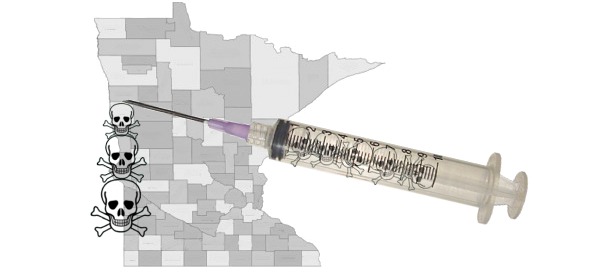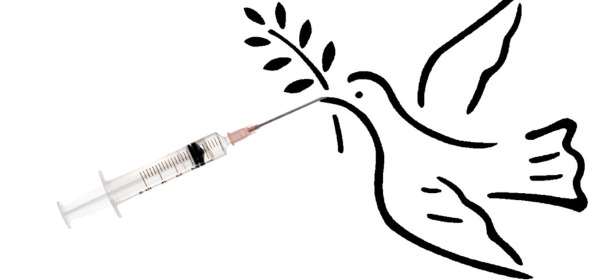Natural Health
Common Weed May Prevent Lung Cancer in Smokers
Lung cancer is particularly virulent and noted as having one of the poorest outcomes. Two recent scientific studies, though, have shown that Polygala senega may be able to prevent the disease or limit its virulence.
Polygala senega is a common and easy to grow weed that is occasionally grown domestically. It carries several common names, including snakeroot, seneca (for the Seneca indians, from whom the name is derived), sneka, milkwort, mountain flax, and rattlesnake root. It’s a perennial in all but the coldest climates—and seeds can be purchased readily from internet sources.
The Studies
The two studies were done by a team in the Cytogenetics and Molecular Biology Laboratory in the Department of Zoology of the University of Kalyani in India. The lead author, Anisur Rahman Khuda-Bukhsh, thanks Boiron Laboratories of France for grants to produce the studies. (Please note that these were not experiments in homeopathy and Boiron did not supply materials.)
In Vitro Study
The first study, “Anticancer Potentials of Root Extract of Polygala senega and Its PLGA Nanoparticles-Encapsulated Form”, published in the journal Evidence-Based and Complementary Medicine on 1 July 2010, investigated the effects of Polygala senega ethanol-based root extract and on a nano-encapsulated form of it. This was an in vitro study that used lab-grown normal and cancerous human cell lines.
Study results are shown in the graph above. In the control line of normal lung cells, nearly all the cells remained viable after 24 hours. When 100 micrograms (μg) of Polygala senega tincture were added, the number of surviving cells was significantly lower, and apoptosis, the natural self-destruction of cells at the end of their life-cycle, was the reason. Application of 200 μg increased the number of cells subjected to apoptosis. Using the nanoparticle encapsulated form of Polygala senega extract resulted in even greater benefit. In all cases, the amount of necrosis, abnormal cellular death, was minimal in all examples, but slightly higher in the noncancerous control cells.
This study showed no adverse effects on normal lung cells, while demonstrating highly significant destruction of cancerous lung cells.
In Vivo Study
The second study, “Anticancer potentials of root extract of Polygala senega against benzo[a]pyrene-induced lung cancer in mice”, was published in the Journal of Chinese Integrative Medicine in March 2011. It investigated the effects of Polygala senega on lung cancer-induced mice. They did physical and histological examinations of the lungs, analyzed DNA damage, and quantified both antioxidant enzyme activity and the tumor suppressor protein, p53.
The mice were intoxicated with benzo[a]pyrene (B[a]P) to induce lung cancer. B[a]P is, by the way, well known to be highly carcinogenic; it’s found in coal tar, auto exhaust, and tobacco smoke. All possible variations of toxin, suspension (olive oil & ethanol), and Polygala senega were examined.
Mice were divided into 5 groups, each containing 6 animals:
- Group 1 Controls: Mice were orally given olive oil by pipette. (All other mice were also orally dosed with pipettes.)
- Group 2: Mice were given benzo[a]pyrene in olive oil at 50 mg/kg body weight 2 times a week for 4 weeks.
- Group 3: Mice were given B[a]P in a combination of olive oil and 48% ethanol 2 times a week for 4 weeks.
- Group 4: Mice were given ethanol extract of Polygala senega (EEPS) to mice intoxicated with B[a]P & olive oil on a daily basis, starting after the first dose of intoxicant and continuing for 16 weeks.
- Group 5: Mice were given only EEPS daily for 16 weeks.
The table below, reproduced from the study article, shows the percentage of DNA damage. The lower the number, the the less DNA damage there is. Tail length refers to the distance that DNA has moved from the nucleus of a cell to the outer edge of the cell. A shorter tail is better.
| Group | Percent of DNA Damage (%) |
Tail Length (µm) |
| Control (olive oil) | 6.35±0.39 | 12.61±0.84 |
| B[a]P & olive oil | 27.02±1.52 | 42.68±2.02 |
| B[a]P & olive oil & ethanol | 26.08±2.23 | 43.08±3.05 |
| B[a]P & olive oil & EEPS | 11.43±0.65 | 19.38±1.52 |
| EEPS (non-intoxicated mice) | 6.35±0.56 | 12.11±0.79 |
This following table shows the results of the p53 protein expression. This protein is a tumor suppressor, so the higher the number, the more there is. As a rule, more is better. Notice that only the Polygala senega by itself even approaches the normal expression of of p53.
| Group | p53 Expression |
| Control (olive oil) | 1.200±0.058 |
| B[a]P & olive oil | 0.529±0.005 |
| B[a]P & olive oil & ethanol | 0.544±0.004 |
| B[a]P & olive oil & EEPS | 0.606±0.005 |
| EEPS (non-intoxicated mice) | 1.010±0.044 |
Lung Cancer Prevention
If you hope to survive lung cancer, the best approach is prevention. Survival rates after diagnosis are simply dismal. Although Polygala senega shows promise as a treatment for lung cancer, that may not be where it’s best applied. However, anyone who is at particular risk for contracting lung cancer—such as mechanics who are regularly exposed to diesel fumes, people who are or have been heavily exposed to burning coal tar, or people who smoke or once smoked cigarettes from Big Tobacco—might want to seriously consider taking a tincture of this herb to help limit the chances of developing lung cancer.
These studies, though certainly not the final word, may be indicative of a method that, according to both studies, has demonstrated no harmful adverse effects. That, of course, should be taken with caution, as the studies are not long term and there have been no in vivo trials on humans.
Finally, though the authors discussed identifying and isolating an active substance from Polygala senega, one must question their goal. Are they more interested in isolating a single chemical for patenting and turning into a pharmaceutical drug? Or are they truly interested in helping people treat and prevent a horrible disease, one that kills by slow and painful suffocation? These researchers seem to be well on the way to documenting a particularly efficacious method of dealing with lung cancer, one that’s far more promising than any of the drugs in current use. It would be tragic if greed were to lead them to promote a solitary chemical, rather than the symbiotic whole of the plant.
Sources:
Tagged alternative medicine, cancer, herbal prevention, herbal treatment cancer, lung cancer, lung cancer polygala senega, polygala senega, polygala senega lung cancer, seneca, seneca herb cancer, smoking lung cancer herb, snakeroot, snakeroot herb cancer






















Pingback: Common Weed May Prevent Lung Cancer in Smokers | Health News Site
Pingback: cascading failure
Pingback: mouse click the following web page
Pingback: similar internet site
Pingback: link
Pingback: more
Pingback: linked site
Pingback: More Bonuses
Pingback: More suggestions
Pingback: resource for this article
Pingback: more resources
Pingback: simply click
Pingback: More Support
Pingback: Ongoing
Pingback: resources
Pingback: similar webpage
Pingback: visit the following web site
Pingback: please click the up coming document
Pingback: simply click the following webpage
Pingback: simply click the next internet site
Pingback: Read Full Article
Pingback: Suggested Webpage
Pingback: mouse click the up coming internet site
Pingback: Ongoing
Pingback: Suggested Webpage
Pingback: please click the following post
Pingback: visit the following internet page
Pingback: visit the next website page
Pingback: Read
Pingback: visit the following website page
Pingback: visit the up coming site
Pingback: Read More In this article
Pingback: Read This method
Pingback: relevant internet page
Pingback: Recommended Looking at
Pingback: related internet page
Pingback: similar site
Pingback: relevant webpage
Pingback: simply click the following site
Pingback: simply click the following article
Pingback: simply click the up coming webpage
Pingback: Suggested Online site
Pingback: Visit
Pingback: source
Pingback: visit the following web page
Pingback: supplemental resources
Pingback: Click Here
Pingback: please click the next page
Pingback: click the next page
Pingback: Read A lot more
Pingback: Read Much more
Pingback: click the up coming site
Pingback: visit the following web site
Pingback: mouse click the next internet page
Pingback: Recommended Webpage
Pingback: Continue Reading
Pingback: Ongoing
Pingback: Click Here
Pingback: Click on
Pingback: please click the following page
Pingback: simply click the following post
Pingback: click the next internet site
Pingback: Highly recommended Webpage
Pingback: just click the following internet site
Pingback: Recommended Internet page
Pingback: This Web page
Pingback: just click the up coming post
Pingback: Related Site
Pingback: related website
Pingback: link
Pingback: linked web-site
Pingback: relevant resource site
Pingback: visit the up coming internet site
Pingback: More about the author
Pingback: similar internet site
Pingback: simply click for source
Pingback: simply click the up coming article
Pingback: resources
Pingback: source for this article
Pingback: simply click the up coming post
Pingback: click the up coming website page
Pingback: Suggested Studying
Pingback: source for this article
Pingback: Suggested Web site
Pingback: click through the following website
Pingback: This Site
Pingback: visit the next internet site
Pingback: visit the following post
Pingback: click through the up coming web site
Pingback: visit the up coming post
Pingback: Click At this website
Pingback: click the following internet site
Pingback: Full Report
Pingback: click the next internet page
Pingback: click the following web page
Pingback: just click the next web page
Pingback: click the up coming website
Pingback: Highly recommended Resource site
Pingback: click through the next internet site
Pingback: click through the next internet site
Pingback: Look At This
Pingback: just click the following internet page
Pingback: click through the up coming article
Pingback: More hints
Pingback: More Material
Pingback: Learn Alot more
Pingback: Full Report
Pingback: Highly recommended Internet page
Pingback: Highly recommended Web-site
Pingback: More Tips
Pingback: mouse click the following internet site
Pingback: relevant web-site
Pingback: just click the next website
Pingback: just click the next document
Pingback: please click the following internet page
Pingback: similar internet page
Pingback: just click the up coming internet page
Pingback: please click the next post
Pingback: please click the next website page
Pingback: Learn Additional Here
Pingback: main page
Pingback: source
Pingback: Read More Listed here
Pingback: Suggested Studying
Pingback: resource for this article
Pingback: similar web site
Pingback: simply click the following website page
Pingback: source for this article
Pingback: visit the next web page
Pingback: simply click the next website
Pingback: Suggested Browsing
Pingback: simply click the up coming website page
Pingback: This Site
Pingback: Suggested Online site
Pingback: This Web-site
Pingback: Suggested Website
Pingback: visit the following site
Pingback: visit the following website
Pingback: visit the up coming post
Pingback: Check This Out
Pingback: click the following internet page
Pingback: click the next document
Pingback: mouse click the following internet site
Pingback: click the next webpage
Pingback: click through the following internet site
Pingback: mouse click the following website page
Pingback: mouse click the following internet site
Pingback: mouse click the next site
Pingback: click through the next document
Pingback: mouse click the up coming article
Pingback: Ongoing
Pingback: click through the up coming webpage
Pingback: Extra resources
Pingback: mouse click the up coming website
Pingback: please click the up coming document
Pingback: please click the next document
Pingback: Read More Here
Pingback: Read the Full Document
Pingback: please click the next web page
Pingback: please click the up coming article
Pingback: Read More At this website
Pingback: Read More
Pingback: Learn Even more Here
Pingback: linked internet site
Pingback: Read More In this article
Pingback: similar web page
Pingback: mouse click on
Pingback: resources
Pingback: Read the Full Posting
Pingback: Recommended Browsing
Pingback: simply click the next internet page
Pingback: simply click the up coming internet page
Pingback: simply click the up coming website page
Pingback: sources
Pingback: Suggested Site
Pingback: Suggested Internet page
Pingback: Suggested Web page
Pingback: relevant webpage
Pingback: Suggested Web page
Pingback: similar resource site
Pingback: visit the up coming site
Pingback: Check This Out
Pingback: click the following webpage
Pingback: simply click the up coming internet page
Pingback: click the next website page
Pingback: next page
Pingback: source for this article
Pingback: click through the following web page
Pingback: please click the following page
Pingback: Suggested Resource site
Pingback: Read the Full Article
Pingback: click through the up coming website
Pingback: Suggested Website
Pingback: Visit
Pingback: Recommended Webpage
Pingback: Full Piece of writing
Pingback: Go At this site
Pingback: visit the following website
Pingback: visit the following website
Pingback: related website
Pingback: visit the next website
Pingback: visit the up coming post
Pingback: just click the next web page
Pingback: simply click the next website
Pingback: simply click the up coming webpage
Pingback: Bonuses
Pingback: click the following article
Pingback: click the following document
Pingback: link
Pingback: linked web site
Pingback: click the next page
Pingback: More hints
Pingback: click the up coming internet site
Pingback: Check Out
Pingback: Click On this page
Pingback: Click This Link
Pingback: click the following page
Pingback: click the up coming site
Pingback: click through the next page
Pingback: click through the next article
Pingback: Suggested Resource site
Pingback: click through the next site
Pingback: Continue
Pingback: click through the up coming web page
Pingback: Full Posting
Pingback: Highly recommended Reading
Pingback: visit the up coming post
Pingback: Discover More Here
Pingback: Full Write-up
Pingback: home-page
Pingback: just click for source
Pingback: Get More Information
Pingback: Going At this website
Pingback: just click the next website
Pingback: Learn Alot more
Pingback: mouse click the up coming website page
Pingback: Going Listed here
Pingback: homepage
Pingback: please click the next document
Pingback: More Tips
Pingback: homepage
Pingback: please click the up coming website page
Pingback: resource for this article
Pingback: Read A great deal more
Pingback: just click the following post
Pingback: similar site
Pingback: simply click the next website
Pingback: Read the Full Report
Pingback: sources
Pingback: keep reading
Pingback: Suggested Reading
Pingback: Recommended Studying
Pingback: just click the up coming site
Pingback: Suggested Web page
Pingback: Recommended Web-site
Pingback: relevant web site
Pingback: visit the next internet site
Pingback: linked webpage
Pingback: mouse click the next internet page
Pingback: mouse click the next web site
Pingback: more
Pingback: simply click the next document
Pingback: simply click the up coming internet site
Pingback: Suggested Online site
Pingback: please click the up coming article
Pingback: Read the Full Piece of writing
Pingback: visit the following site
Pingback: similar web site
Pingback: visit the up coming post
Pingback: relevant internet site
Pingback: simply click the following site
Pingback: Click On this site
Pingback: similar webpage
Pingback: click the next internet page
Pingback: simply click the next site
Pingback: simply click the following website page
Pingback: simply click the next website
Pingback: sources
Pingback: simply click the up coming site
Pingback: click the up coming webpage
Pingback: Suggested Website
Pingback: Suggested Internet page
Pingback: visit the following page
Pingback: click through the next site
Pingback: visit the following website page
Pingback: Continue
Pingback: visit the next web site
Pingback: visit the following internet page
Pingback: Full Content
Pingback: Full Posting
Pingback: visit the following web page
Pingback: Click On this website
Pingback: click the next internet page
Pingback: click through the following internet site
Pingback: visit the up coming document
Pingback: Highly recommended Website
Pingback: click through the next article
Pingback: just click the next document
Pingback: Full Document
Pingback: Full Post
Pingback: Learn Even more Here
Pingback: Going at
Pingback: Highly recommended Internet site
Pingback: Highly recommended Resource site
Pingback: just click the following page
Pingback: mouse click the next site
Pingback: More Material
Pingback: relevant web-site
Pingback: please click for source
Pingback: just click the up coming internet site
Pingback: Learn Even more Here
Pingback: please click the next internet page
Pingback: similar resource site
Pingback: simply click the following page
Pingback: linked site
Pingback: More about the author
Pingback: More methods
Pingback: simply click the up coming article
Pingback: simply click the up coming webpage
Pingback: relevant web-site
Pingback: stay with me
Pingback: simply click for source
Pingback: simply click the next document
Pingback: visit the following page
Pingback: visit the following web site
Pingback: Recommended Online site
Pingback: Suggested Website
Pingback: visit the up coming site
Pingback: visit the following internet site
Pingback: relevant web site
Pingback: mouse click the following web site
Pingback: similar web site
Pingback: mouse click the following web page
Pingback: mouse click the next document
Pingback: next page
Pingback: mouse click the up coming website page
Pingback: please click the next document
Pingback: please click the following post
Pingback: Read More Here
Pingback: Read Even more
Pingback: Read the Full Article
Pingback: Read
Pingback: Recommended Internet site
Pingback: Read This method
Pingback: Read Full Article
Pingback: visit the up coming site
Pingback: related web-site
Pingback: Read the Full Post
Pingback: relevant website
Pingback: mouse click the up coming webpage
Pingback: similar internet page
Pingback: Recommended Webpage
Pingback: please click the next document
Pingback: simply click the following site
Pingback: simply click the following web site
Pingback: relevant webpage
Pingback: Suggested Studying
Pingback: read on
Pingback: Read the Full Piece of writing
Pingback: This Web-site
Pingback: simply click the following site
Pingback: visit the following website
Pingback: visit the following website page
Pingback: simply click the next internet page
Pingback: visit the next website
Pingback: article source
Pingback: Click In this article
Pingback: source for this article
Pingback: Suggested Internet site
Pingback: click the following post
Pingback: click the following website
Pingback: click the up coming document
Pingback: click the up coming article
Pingback: This Resource site
Pingback: click the up coming web site
Pingback: visit the following post
Pingback: click through the up coming page
Pingback: visit the next web page
Pingback: our website
Pingback: Full Document
Pingback: Click Here
Pingback: please click the next post
Pingback: click the next page
Pingback: Home Page
Pingback: mouse click the next article
Pingback: click the next website
Pingback: mouse click the up coming webpage
Pingback: please click for source
Pingback: Highly recommended Web-site
Pingback: just click the up coming site
Pingback: click through the following web page
Pingback: Read This method
Pingback: Read
Pingback: just click the up coming post
Pingback: More inspiring ideas
Pingback: Read the Full Article
Pingback: click through the up coming post
Pingback: Learn Alot more
Pingback: Recommended Internet site
Pingback: relevant website
Pingback: Recommended Looking at
Pingback: simply click the following internet page
Pingback: More Help
Pingback: Going at
Pingback: More Support
Pingback: simply click the next web page
Pingback: relevant website
Pingback: simply click the following webpage
Pingback: Highly recommended Site
Pingback: source
Pingback: this website
Pingback: simply click the next internet site
Pingback: just click the up coming post
Pingback: simply click the up coming web site
Pingback: visit the following internet site
Pingback: Learn More Here
Pingback: main page
Pingback: Suggested Webpage
Pingback: More Help
Pingback: click for source
Pingback: relevant website
Pingback: visit the next website
Pingback: click the up coming document
Pingback: similar internet site
Pingback: click the up coming website
Pingback: simply click the following page
Pingback: Continue
Pingback: Continued
Pingback: This Webpage
Pingback: Get the facts
Pingback: Highly recommended Online site
Pingback: visit the up coming post
Pingback: just click the following web page
Pingback: just click the next website page
Pingback: just click the up coming internet page
Pingback: linked internet site
Pingback: More about the author
Pingback: More Support
Pingback: relevant web-site
Pingback: simply click the following article
Pingback: simply click the next document
Pingback: Suggested Online site
Pingback: This Web page
Pingback: visit the next page
Pingback: visit the next website
Pingback: cigarette electronique
Pingback: cigarette electronique
Pingback: website consulting
Pingback: Due dilligence
Pingback: lead generation
Pingback: Website maintenance